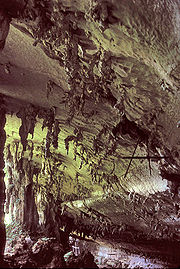
Niah Caves
Encyclopedia

Miri
Miri is a city in northern Sarawak, Malaysia, on the island of Borneo. It is the second largest city in Sarawak, with a population of about 300,000, and the government administrative centre of Miri District in Miri Division....
in Sarawak
Sarawak
Sarawak is one of two Malaysian states on the island of Borneo. Known as Bumi Kenyalang , Sarawak is situated on the north-west of the island. It is the largest state in Malaysia followed by Sabah, the second largest state located to the North- East.The administrative capital is Kuching, which...
, Malaysia. Part of Niah National Park, the main cave, Niah Great Cave, is located in Gunung Subis and is made up of several voluminous, high-ceilinged chambers. The Great Cave lies in a large limestone
Limestone
Limestone is a sedimentary rock composed largely of the minerals calcite and aragonite, which are different crystal forms of calcium carbonate . Many limestones are composed from skeletal fragments of marine organisms such as coral or foraminifera....
block, about a kilometre long in general north to south direction and about half a kilometre wide, that is detached from the main Gunung Subis complex, by a valley between about 150 to 200 meters wide. The main Gunung Subis complex rises to about 394 meters above sea level at its highest point. The whole "Gunung Subis Limestone Complex" lies some 17 kilometres inland from the South China Sea
South China Sea
The South China Sea is a marginal sea that is part of the Pacific Ocean, encompassing an area from the Singapore and Malacca Straits to the Strait of Taiwan of around...
coast and about 65 kilometres south west of the town Miri. It is roughly heart shaped measuring five kilometres from its northern tip to the south and four kilometres across. The Gunung Subis is surrounded by a low countryside with gentle hills from which the small limestone massiv and its smaller detached blocks rise rather appruptly out of the jungle, some with cliffs over 100 metres high. Though it is not an extensive cave system compared to others in Sarawak, it has been estimated to cover some 10 hectares and the roof rises to about 75 metres above the cave floor in some places. In geological terms, the limestones are part of the Subis Formation. This is dated to some 20 to 16 million years ago during the Early Miocene. The caves have been used by humans at different times ranging from the prehistory to neolithic, chinese Sung-Era and more recent times.
The cave is an important prehistorical site where human remains dating to 40,000 years have been found. This is the oldest recorded human settlement in east Malaysia. More recent studies published in 2006 have shown evidence of the first human activity at the Niah caves from ca. 46,000 to ca. 34,000 years ago. Painted Cave, situated in a much smaller limestone block of its own, some 150 metres from the Great Cave block's south eastern tip, has rock paintings dated as 1,200 years old. The caves are also well known for the birds' nest
Bird's nest soup
Bird's nest soup is a delicacy in Chinese cuisine. A few species of swift, the cave swifts, are renowned for building the saliva nests used to produce the unique texture of this soup....
(Swiftlet
Swiftlet
Swiftlets are birds contained within the four genera Aerodramus, Hydrochous, Schoutedenapus and Collocalia. They form the Collocaliini tribe within the swift family Apodidae. The group contains around thirty species mostly confined to southern Asia, south Pacific islands, and northeastern...
) industry. It is a popular tourist destination in Sarawak.
Research was pioneered by Tom Harrisson
Tom Harrisson
Major Tom Harnett Harrisson DSO OBE was a British polymath. In the course of his life he was an ornithologist, explorer, journalist, broadcaster, soldier, guerrilla, ethnologist, museum curator, archaeologist, documentarian, film-maker, conservationist, and writer...
in the 1950/60s. Since then local universities and foreign scientists have continued the archaeological research, and many articles have been published in the Sarawak Museum Journal. The site has been re-excavated (1999-2003+) by a joint British-Malaysian expedition to determine the accuracy of Harrisson's work.
Items found at Niah Cave include Pleistocene chopping tools and flakes, Neolithic axes, adzes, pottery, shell jewellery, boats, mats, then iron tools and ceramics and glass beads dating to the Iron Age
Iron Age
The Iron Age is the archaeological period generally occurring after the Bronze Age, marked by the prevalent use of iron. The early period of the age is characterized by the widespread use of iron or steel. The adoption of such material coincided with other changes in society, including differing...
. The most famous find is the human skull dated at around 38,000 years BCE.
Painted Cave has paintings and wooden coffin 'death ships'.
Niah National Park was 31.4 km² when it was gazetted in 1974.
Nomination for World Heritage status was sent to UNESCO in 2010.
Further reading
External links
- A short description of the caves as a touristic destination.
- Summary of the article "A short history of birds' nests management in the Niah caves (Sarawak)." by Quentin Gausset from the "Borneo Research Bulletin" published in 2002.
- Another version from the Sarawak Forestry with a map of the caves
- Article with a picture of some paintings and death ships.
- Picture of some cave paintings.

